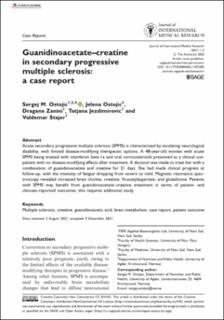Guanidinoacetate–creatine in secondary progressive multiple sclerosis: a case report
Peer reviewed, Journal article
Published version
Permanent lenke
https://hdl.handle.net/11250/3064835Utgivelsesdato
2022Metadata
Vis full innførselSamlinger
Originalversjon
Ostojic, S., Ostojic, J., Zanini, D., Jezdimirovic, T. & Stajer, V. (2022). Guanidinoacetate–creatine in secondary progressive multiple sclerosis: a case report. Journal of International Medical Research, 50 (1), 1-5. doi: 10.1177/03000605211073305Sammendrag
Acute secondary progressive multiple sclerosis (SPMS) is characterized by escalating neurological disability, with limited disease-modifying therapeutic options. A 48-year-old woman with acute SPMS being treated with interferon beta-1a and oral corticosteroids presented as a clinical out- patient with no disease-modifying effects after treatment. A decision was made to treat her with a combination of guanidinoacetate and creatine for 21 days. She had made clinical progress at follow-up, with the intensity of fatigue dropping from severe to mild. Magnetic resonance spec- troscopy revealed increased brain choline, creatine, N-acetylaspartate, and glutathione. Patients with SPMS may benefit from guanidinoacetate–creatine treatment in terms of patient- and clinician-reported outcomes; this requires additional study.

